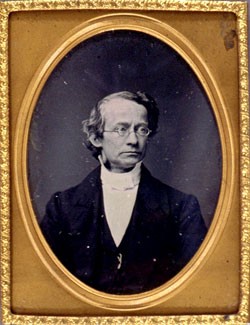Water Wash Conservation Technique
The second level of treatment on the daguerreotypes involved
washing the plates in a bath of warm water. As with the dry cleaning
treatment, the conservator first removed the daguerreotype plate
from its housing and dusted the surface with compressed air. Once
any loose surface debris was removed he then immersed the plate
in warm deionized water, and then dried it through a succession
of solvent baths. The cover glass was cleaned, the plate re-sealed
and returned to its original enclosure or a new one was made.
|
|
This daguerreotype was first slated to be washed only with a
water wash, but after further examination the conservator noted
a potentially active corrosion due to a prior treatment. As a
result the plate was washed in a solution of dilute ammonium hydroxide;
a process between the water wash and electro-cleaning.
|

Portrait of Edward Blanchard Edgar (Class of 1835),
1857. Quarter plate daguerreotype. Photographer unknown |

Triple portrait of John Buhler (Class of 1846), Mary Meaux Reynolds,
and Walter Turnbull Scott (Class of 1845), ca. 1847. Half plate
daguerreotype. Photographer: E. Jacobs, New Orleans |
Despite the incursion of corrosive material on this daguerreotype
plate, the three individuals portrayed remain visible. Thus, rather
than electro-clean the plate, it was washed with water. A comparison
between the before and after images shows what a significant difference
can be made by cleaning off surface debris and washing the cover
glass.
Hover over the image of Buhler, Reynolds
and Turnbull with your mouse to see the image after treatment.
|

